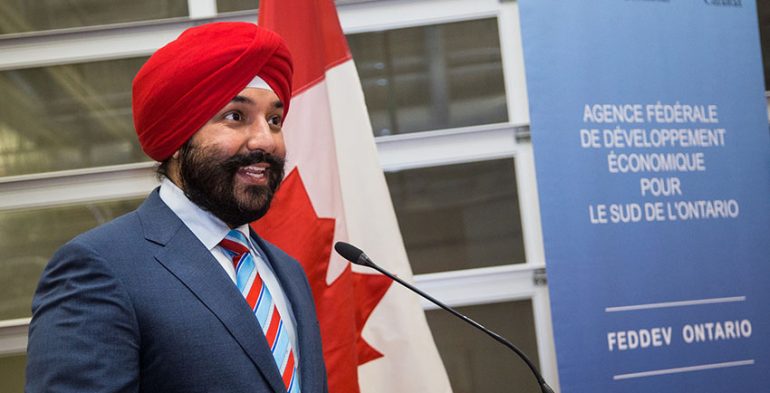The Canadian government has launched additional details related to its Intellectual Property Strategy, aimed at tackling the problem of companies struggling to commercialize after doing the work of research and invention.
The IP Strategy falls into three buckets: legislation, increasing the literacy of companies when it comes to IP, and providing tools to navigate IP.
“We know IP is a critical ingredient in helping Canadian businesses reach commercial success,” said Navdeep Bains, Minister of Innovation, Science and Economic Development. “Canada’s IP Strategy will make sure Canadians know the value of their intellectual property and how to leverage it to innovate, increase profits, and create middle-class jobs.”
Amending legislation
The IP Strategy will amend key IP laws with the goal of removing barriers to innovation, with a focus on loopholes that allow people trying to use IP in bad faith to stall innovation for their own gain. Specifically, it will clarify acceptable practices in the Patent Act, Copyright Act, and Trademarks Act.
The Patent Act will be amended to create new minimum requirements for patent demand letters, discourage the sending of deceptive and vague letters, and reducing costs for the recipient in assessing the merits of the allegations. Requirements will mandate that basic information, such as patent number and product or activities, will need to be included in a demand letter alleging infringement.
Amendments will also be made to the Patent Act to affirm that conducting experiments related to the subject matter of a patent does not qualify as patent infringement. However, resulting inventions still need to abide by existing patent laws before being sold or used for commercial benefit.
The Copyright Act will be amended so that settlement demands will be excluded from the copyright Notice and Notice regime, which the government said will protect consumers and ensure that the Notice and Notice regime remains effective in discouraging infringement.
The IP Strategy will create independent oversight for Patent and Trademark Agents, called the College of Patent and Trademark Agents, to ensure that professional and ethical standards are maintained. New trademark bad faith opposition grounds will be introduced to prevent the cluttering and misuse of the trademark registration system, sometimes referred to as trademark squatting. Users will also be required to enforce a trademark within the first three years after registration.
Communications with IP agents are protected by statutory privilege in the same way as solicitor-client advice.
Increasing literacy
When it comes to increasing literacy of IP, the government’s Canadian Intellectual Property Office (CIPO) will be launching several programs. CIPO will continue to offer IP Seminars and webinars on the foundations of IP, Patents 101, IP Strategy, and Protecting your IP in China, and is currently building an online toolkit to help users make more informed decisions related to IP. Federal employees dealing with IP governance will get additional training.
With $17.5 million over five years, the government is creating a dedicated team of IP advisors who will work through existing federal programs to ensure that government’s the program officers have the knowledge and capacity to address IP issues and guide program recipients. These advisors won’t provide legal advice, but they will tackle issues such as patent leakage.
“For SunSaluter, holding a patent for my invention allows our non-profit organization to protect ourselves while we openly share the technology with others around the world who can benefit from our work,” said Eden Full Goh, founder of SunSaluter. “The SunSaluter technology has impacted over 15,000 people in 19 countries and counting.”
The IP strategy calls for the formation of the Indigenous Intellectual Property Issues initiative, which aims to support Indigenous participation in national and international discussions about IP and how it interacts with traditional knowledge and cultural expression; $1 million over five years is earmarked for this. The initiative will include support for Indigenous peoples’ participation in the World Intellectual Property Organization Intergovernmental Committee on Intellectual Property and Genetic Resources, Traditional Knowledge and Folklore.
$1 million over five years will go toward the creation of IP legal clinics to help law students to learn more about IP, help businesses get a sense of their IP needs, and facilitate access to basic IP advice.
The patent collective
A $30 million one-time grant is going toward the patent collective where businesses can share expertise and get access to a collection of IP.
A third party chosen through an RFP process will create a platform for SMEs to share and access IP and related strategies. Acquired patents and knowledge could provide either “freedom to operate,” where a firm may need access to a patented technology in order to commercialize its own invention without risk of infringement, or the basis of a defensive infringement countersuit. The government said where there are technological areas with many overlapping patents, the ability to countersue a party alleging infringement for infringement of your own patent can lead to better outcomes.
The IP strategy was first announced in Budget 2018, when it dedicated $85.3 million over five years, with $10 million per year ongoing, towards this strategy. At the time, specific details weren’t made available.
“Intangible assets such as IP and data are essential stocks for companies to own and commercialize if they want to scale up globally,” said Benjamin Bergen, executive director of the Council of Canadian Innovators. “Today’s announcement is a very welcome development for domestic innovators because it shows the government understands the global economy where our members compete and freedom-to-operate they need to grow their businesses.”


